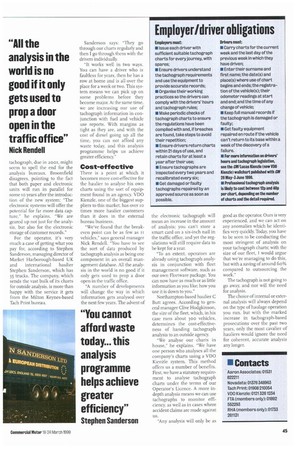"All the analysis in the world is no good if
Page 47

If you've noticed an error in this article please click here to report it so we can fix it.
it only gets used to prop a door open in the traffic office"
Nick Rendell
tachograph, due in 200T, might seem to spell the end for the analysis bureaux. Broomfield disagrees, pointing to the fact that both paper and electronic units will run in parallel for some To years after the introduction of the new system: "The electronic systems will offer the potential for far more data capture," he explains. "We are geared up not just for the analysis, but also for the electronic storage of customer records."
For the operator, it's very much a case of getting what you pay for, according to Stephen Sanderson, managing director of Market Ha rborough-based UK and international haulier Stephen Sanderson, which has 35 trucks. The company, which sends the vast bulk of its charts for outside analysis, is more than happy with the service it gets from the Milton Keynes-based Taal Print bureau. Sanderson says: "They go through our charts regularly and then I go through them with the drivers individually.
"It works well in two ways. You can have a driver who is faultless for years, then he has a row at home and is all over the place for a week or two. This system means we can pick up on some problems before they become major. At the same time, we are increasing our use of tachograph information in conjunction with fuel and vehicle use reports. With margins as tight as they are, and with the cost of diesel going up all the time, you can not afford any waste today, and this analysis programme helps us achieve greater efficiency"
Cost-effective
here is a point at which it becomes more cost-effective for the haulier to analyse his own charts using the sort of equipment found in an agency. VDO Kienzle, one of the biggest suppliers to this market, has over to times more haulier customers than it does in the external bureau business.
"We've found that the breakeven point can be as few as IT vehicles," says general manager Nick Rendell. "You have to see the sort of data produced by tachograph analysis as being one component in an overall management database. All the analysis in the world is no good if it only gets used to prop a door open in the traffic office.
"A number of developments will change the way in which information gets analysed over the next few years. The advent of the electronic tachograph will mean an increase in the amount of analysis; you can't store a smart card on a six-inch nail in the traffic office, and yet the regulations will still require data to be kept for a year.
"To an extent, operators are already using tachograph analysis in conjunction with fleet management software, such as our own Fleetware package. You can now have as much or as little information as you like; how you use it is down to you."
Northampton-based haulier C Butt agrees. According to general manager Clive Hodgkinson, the size of the fleet, which, in his case runs about 300 vehicles, determines the cost-effectiveness of handing tachograph analysis to an outside agency.
"We analyse our charts in house," he explains. "We have one person who analyses all the company's charts using a VDO Kienzle system. This method offers us a number of benefits. First, we have a statutory requirement to analyse tachograph charts under the terms of our Operator's Licence. A more indepth analysis means we can use tachographs to monitor efficiency, as well as in cases where accident claims are made against us.
"Any analysis will only be as good as the operator. Ours is very experienced, and we can act on any anomalies which he identifies very quickly. Today, you have to be seen to be conducting the most stringent of analysis on your tachograph charts; with the size of our fleet, I would argue that we're managing to do this, but with a saving of around Go% compared to outsourcing the work."
The tachograph is not going to go away, and nor will the need for analysis.
The choice of internal or external analysis will always depend on the type of haulage operation you run, but with the marked increase in tachograph-based prosecutions over the past two years, only the most cavalier of hauliers would ignore the need for coherent, accurate analysis any longer.




















































































































